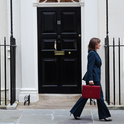It is hard to find two national leaders who are more alike. As I wrote for Prospect last year, Keir Starmer and Australian prime minister Anthony Albanese are the same age and both lead their nation’s Labo(u)r party. They have both tacked from left to right across their careers. They both took their parties back into office but then struggled with a sense of listlessness and dithering.
But in 2025, their fates have diverged. Starmer has plumbed new depths of unpopularity and his party was flogged at last week’s local elections. Conversely, Albanese steadily improved his party’s popularity in the new year. He called an election on 27th March—the very day the Australian Labor Party (ALP) pulled ahead of its main opposition, the conservative Coalition, in the polls.
On election night, it was revealed the polls had underestimated the extent of the ALP’s recovery. With more than 80 per cent of the lower house ballots counted so far, Labor is sitting on 90 seats against the Coalition’s mere 40. The Coalition leader Peter Dutton even lost his own seat. It was a wipeout beyond Albanese’s wildest dreams.
Starmer, whose team assiduously studies its Australian counterpart, will be comforted by his peer’s win. It proves it’s never too late to turn things around. And Starmer has much more time to do so.
But how to go about it? No foreign election result provides a precise roadmap, of course. But given the similarities of personnel and circumstance, lessons will inevitably be drawn.
Let’s start by dispelling one strategy which is not supported by the Australian result. Albanese did not follow the lead of Canadian prime minister Mark Carney in making standing up to Donald Trump the centrepiece of his campaign. Albanese took a much less confrontational tone, and foreign affairs weren’t top of mind for most voters. Starmer has arguably gone further in his concerted niceness—some would say obsequiousness—toward the US president, and one could argue that putting greater distance between himself and Trump might be strategically sound or electorally popular. But you’d need to look elsewhere for backup.
That’s not to say, however, that there was no “Trump factor” in Australia—it was just focused domestically. Under the influence of mining billionaire Gina Rinehart, who attended Trump’s election night party at Mar-a-Lago, Dutton’s team made a series of controversial announcements that were obviously cribbed from Elon Musk’s Department of Government Efficiency (Doge). These included appointing Senator Jacinta Price as “shadow minister for government efficiency”, promising to cut 36,000 to 41,000 public service jobs (that’s approximately one in five), and preventing public servants from working from home.
These efforts were interpreted by many Australians, not unreasonably, as an effort to dampen full employment generally and embolden private sector employers to likewise revoke flexible working arrangements. Thus, they went down like lead balloons. Shadow ministers scrambled to “clarify” and water down these policies to avoid the stench of Doge and austerity, but Price undermined their efforts by controversially vowing to “make Australia great again”. The threats posed by this agenda, plus by the Coalition’s ham-fisted nuclear power policy, were successfully driven home by Labor.
Albanese also grew more forthright on policy. He had long suffered from the perception that his government wasn’t doing enough to alleviate the cost-of-living crisis. The excuses—not wanting to fuel inflation or damage the budget bottom line—fell on deaf ears. But as the election drew closer, the ALP finally started announcing policies that demonstrated concern. These included significantly increasing funding to Medicare (Australia’s equivalent to the NHS) to ensure 90 per cent of doctors’ visits are free to the patient; wiping 20 per cent off student debts; shaving AUD$150 off electricity bills; and lowering the cost of childcare and prescription drugs.
The lessons for Starmer? First, find your opponents’ weaknesses and go for the jugular. In the present moment, it helps if those weaknesses chime with those of the White House. Kemi Badenoch thinks Doge “isn’t radical enough”. Nigel Farage wants to use Reform’s council victories to put a “Doge in every county”, and stop council staff working from home. It sounds like they’re asking for some Albanese-style attack ads.
The second lesson reinforces the first: your policies must accentuate the contrast. You can’t credibly attack your opponents for threatening to hit people’s pockets unless you are offering to actively better them. Number 10 won’t want to hear this, but this might require reversing the winter fuel and disability payment cuts—and definitely not imposing further welfare cuts, as sources suggest the government might. Beefing up Labour’s economic and social policies, and actually singing the praises of its current efforts in these areas, must also be part of the plan.
The final strategy that is not supported by the Australian experience is lurching to the right on social issues and immigration. Those in the Blue Labour camp might point to the ALP’s history of controversial compromises on immigration and asylum seeker policy to support their own impulses.
Dutton had long styled himself as a “strong borders” leader, making a name for himself as a hardline immigration minister under the previous Coalition government. Migration increased during Labor’s term before it modestly wound back the international student intake, so Dutton tried to wrestle the spotlight onto his pet topic.
In the end, however, his efforts failed. Due to Labor’s belated policy announcements and the Coalition’s missteps, public debate kept reverting to the cost of living, which is more favourable territory for a social democratic party. One could argue that taking certain uncomfortable positions in the immigration portfolio helped the ALP neutralise the issue; though one could also argue that decreasing the salience of immigration by increasingly focusing on voters’ basic economic concerns sealed the deal.
“Taking a leaf” out of Trump’s book by setting up an inquiry into grooming gangs and “cracking down” on migrants generally, as Labour’s red wall convener Jo White has suggested, is unlikely to keep immigration off the front pages. Indeed, increasing the salience of your opponents’ core issues is a recipe that has repeatedly failed for mainstream parties in combating the far right.
As political scientist Ben Ansell recently wrote, “The lesson Labour can learn from Mark Carney and Anthony Albanese is that voters want you to show a little fight. To pick an enemy and explain why voters should vote for you and against them. If you are not going to go straight after Nigel Farage but are going to keep saying ‘well, he has a point but please vote for us anyway’, you are going to fail and you will deserve to have failed.”
Albanese famously stated that he was born to “fight Tories” and rediscovered this vigour just in time. Does Starmer have it in him to follow suit?












